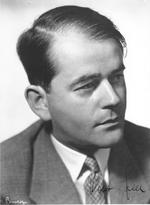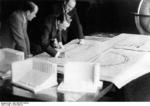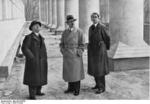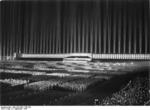Albert Speer
| Surname | Speer |
| Given Name | Albert |
| Born | 19 Mar 1905 |
| Died | 1 Sep 1981 |
| Country | Germany |
| Category | Government |
| Gender | Male |
Contributor: C. Peter Chen
ww2dbaseBerthold Konrad Hermann Albert Speer was born in Mannheim, Germany, into a wealthy middle class family to Albert and Luise Speer. In 1918, moved to Schloss-Wolfsbrunnenweg, Heidelberg, Germany. He originally wanted to become a mathematician, but his father advised against the wish, suggesting that he would "lead a life without money, without a position, and without a future". Instead, Speer followed his father's footsteps and became an architect after studying at University of Karlsruhe, Technical University of Munich, and Technical University of Berlin. In 1927, he worked as Heinrich Tessenow's assistant, who was also his teacher at Technical University of Berlin prior to his graduation. In the summer of 1922, he met Margarete Weber, who he married on 28 Aug 1928; they would later have six children.
ww2dbaseIn Dec 1930, Speer attended a Nazi Party rally and was impressed with Adolf Hitler. Several weeks later, he attended another rally, and was disturbed by the way Joseph Goebbels emotionally triggered the crowd into a frenzy. Nevertheless, he joined the party on 1 Mar 1931, largely due to the impression Hitler made on him. As the only person in the Wannsee suburb of Berlin, Germany who owned a car, he became the Nazi Party's motorist association for the area. In 1931, he resigned as Tessenow's assistant and became a property manager for his father's several real estate properties. In Jul 1932, he visited Berlin to offer help for the Nazi Party for the upcoming Reichstag elections, and he was recommended by Karl Hanke, a former Nazi Party superior of Speer's, to Goebbels to renovate the Nazi Party's Berlin headquarters. After the Nazi Party gained power in Berlin, now Propaganda Minister Goebbels commissioned Speer to renovate his ministry building on Wilhelmplatz and to design the 1933 May Day commemoration. When he worked on the 1933 Nuremberg Nazi Party rally, he came in contact with Hitler for the first time, though Hitler hardly paid attention to him as he presented the plans; absent-mindedly, Hitler made Speer the Commissioner for the Artistic and Technical Presentation of Party Rallies and Demonstrations. It was not until Speer took on the project to design Hitler's Chancellery that Hitler and Speer actually worked together. After one of the daily meetings, Hitler invited Speer to join him for lunch, and asked him to help designing structures for a new Germany. Hitler described Speer as his "kindred spirit" for whom he had always maintained "the warmest human feelings". Later, during the Nuremberg Trials, Speer noted that from that "[i]f Hitler had had any friends at all, [he] certainly would have been one of his close friends." In 1934, Hitler appointed him as the head of the Chief Office for Construction. In this role, he designed the 340,000-seat stadium Zeppelinfeld, which was surrounded by 130 large anti-aircraft searchlights; the grand stadium was later described by British Ambassador Neville Henderson as a "cathedral of ice" or by others "cathedral of light". He employed an unorthodox planning method nicknamed "ruin value"; when he designed the grand Nazi-themed structures, he designed them in such a way that, when they became ruins thousands of years in the future, they would leave a legacy for Germany in the same manner as Greek and Roman ruins. In 1936, he was one of the architects working on the Berlin Olympic Stadium, and in 1937, he designed the German Pavilion for the international exposition in Paris, France. In 1937, Hitler appointed Speer as the General Building Inspector for the Reich Capital with the rank of undersecretary of state in the government; it also made him a member of the Reichstag. In this position, he was charged to rebuild Berlin; his plan involved building a grand boulevard called Prachtstrasse, an assembly hall with a dome over 210 meters high, and a large arc at the opposite end of the assembly hall, but the plans were delayed, then abandoned, due to the start of the European War. When Speer's father saw the model for the new Berlin, he said to Speer "[y]ou've all gone completely insane." In 1938, he rebuilt the Chancellery on the same site as the existing structure in only nine months; Hitler was extremely impressed with the new structure, but his former mentor Tessenow thought the work was too rushed thus almost unacceptable.
ww2dbaseAs the European War began, Speer voiced support for the conquest of Poland. "Of course I was perfectly aware that [Hitler] sought world domination", he later said. "That was the whole point of my buildings. They would have looked grotesque if Hitler had sat still in Germany. All I wanted was for this great man to dominate the globe." In war time, Speer organized squads to construct roads or clear away debris in order to assist the military; he also worked with the Army and the Air Force to construct military facilities. In 1940, Joseph Stalin invited Speer to visit Moscow, Russia, but Hitler ordered Speer to reject the invitation. On 8 Feb 1942, Minister of Armaments Fritz Todt died in a plane crash, and Hitler appointed Speer the successor. Speer centralized power over the war economy in order to improve Germany's war time production capabilities, and placed military experts as departmental leadership positions in his ministry. Goebbels noted in his diary in Jun 1943 that "He is truly a genius with organization." Some of his efforts were undermined by Hitler's dabbling; for example, when Speer suggested that German women could be drafted to work in armament production, Hitler, at Fritz Sauckel's suggestion, imported forced laborers from conquered territories instead. On 10 Dec 1943, when Speer visited the underground Mittelwerk V-2 rocket factory, he was appalled by the treatment of workers drafted from concentration camps. He ordered the working and living conditions to improve for these workers, but his ministry put forth little effort toward that order. After the war, Speer maintained that witnessing the forced laborers were essentially the extent of his knowledge of the Holocaust during the war; he claimed that he would not realize the full horrors of concentration camps until after the war. His claim of not realizing the extent of the Holocaust is still widely disputed.
ww2dbaseIn Jan 1944, Speer fell ill, and was unable to work for three months. During that time, Hermann Göring and Heinrich Himmler conspired to usurp Speer's influence. In Apr 1944, the responsibility for construction was removed from Speer, and he wrote Hitler a bitter letter to offer his resignation. Field Marshal Erhard Milch, however, brokered a deal between Hitler and Speer, which included the return of construction responsibilities to Speer. In Jul 1944, a plot to assassinate Hitler and overthrow his government commenced and failed, and Speer was implicated as his name appeared on a plan to establish a post-Hitler government. He escaped from prosecution as a question mark was drawn next to his name, with the comment "to be won over".
ww2dbaseOn 19 Mar 1945, Hitler issued the Nero Degree, which was essentially a scorched earth policy for territories about to be taken over by Germany's enemies. Originally Hitler's order circumvented Speer's authority, but Speer was able to persuade Hitler otherwise, and then used the newly regained power to work with various local Nazi Party leaders to save various buildings, factories, and infrastructure from being destroyed, which would harm the post-war Germany. He had the thought of assassinating Hitler at this late stage of the war in an attempt to save Germany from further destruction, going as far as scouting the Chancellery grounds for a suitable vent to drop poison gas capsules, giving up when he had discovered that all vents were placed on 12-foot high chimneys, out of his reach. When Germany was about to fall, he was relatively safe in Hamburg, Germany, but he chose to return to Berlin to see Hitler one more time. On 22 Apr, he entered Hitler's bunker and saw Hitler for the last time, where he admitted his efforts to sabotage Hitler's scorched earth orders, and he was forgiven by Hitler. Speer left the bunker in the morning of 23 Apr, toured the damaged Chancellery for the last time, and returned to Hamburg.
ww2dbaseOn 29 Apr, the day before Hitler's suicide, Hitler compiled a list of government officials to succeed his government. Speer's name was missing from the list; in fact, Hitler specified that Speer was to be replaced by Karl-Otto Saur.
ww2dbaseAfter Hitler's death, Speer was a member of Karl Dönitz's government. Between 15 and 23 May, he provided information to the Americans on the effects of the air war on German production. On 23 May, he was arrested and was taken to several internment camps for Nazi German officials. In Sep 1945, at the Nuremberg Trials, he was accused of crime against peace, waging wars of aggression, war crimes, and crime against humanity. United States Supreme Court Justice Robert Jackson, the chief American prosecutor at Nuremberg, alleged that "Speer joined in planning and executing the program to dragoon prisoners of war and foreign workers into German war industries, which waxed in output while the workers waned in starvation." Speer's attorney Dr. Hans Flächsner presented Speer as an architect who was an unwilling player in German politics, but Speer particularly noted that he was willing to hold responsibility as he was one of Hitler's closest associates. During the trial, Speer also confessed of his plot to assassinate Hitler in early 1945 after realizing Hitler's actions would bring Germany to ruin, but this confession was largely met with skepticism, both with the Tribunal as well as the other defendants. He was found guilty on war crimes and crimes against humanity, and was sentenced to 20 years imprisonment on 1 Oct 1946. The judgment stated that
ww2dbaseOn 18 Jul 1947, Speer and six fellow prisoners were transferred to Spandau Prison in Berlin. His fellow prisoners treated him with disrespect as he was the only one who accepted responsibility for crimes conducted by the Nazi government. In secret, against the rules, he wrote his memoirs which would eventually become the book Inside the Third Reich. His letters to his children, also sent in secret, became the basis for the later book Spandau: The Secret Diaries. While imprisoned, he meticulously calculated the distance he walked each day in the exercise yard, and imagined that he was traveling the world on foot. When he was released on 1 Oct 1966, he had, in his imagination, walked from northern Germany to the Middle East, across Siberia into Alaska, and down to near Guadalajara, Mexico. While in prison, he also read over 500 books and built a garden that the American commander at Spandau described as "Speer's Garden of Eden".
ww2dbaseUpon his release, Speer abandoned initial wishes to return to architecture. He published the two books that he had started while in prison, and then began researching on what would become a book on Heinrich Himmler and the SS. He donated large sums of money to Jewish charities, estimated at about 80% of his royalty income, and most of the donations were made anonymously in fear of rejection. As his experience in Spandau, former colleagues kept their distance from him as Speer called many former Nazi leaders "criminals", including Adolf Hitler. In Oct 1973, he traveled to the United Kingdom under a fake name for a BBC interview, and was discovered at Heathrow Airport; he was allowed by Home Secretary Robert Carr a special 48-hour pass to conduct the interview. He returned to London, England, United Kingdom in 1981 for another BBC interview; during this trip, he suffered a stroke and passed away at the age of 76.
ww2dbaseSources:
William Shirer, The Rise and Fall of the Third Reich
Wikipedia
Last Major Revision: May 2009
Albert Speer Interactive Map
Photographs
 |  |  |  |
Albert Speer Timeline
| 19 Mar 1905 | Albert Speer was born. |
| 8 Feb 1942 | In Germany, Albert Speer was appointed the Minister of Armaments and Munitions to succeed Fritz Todt who was killed when his aircraft exploded shortly after take off near Rastenburg, Ostpreußen (East Prussia), Germany. |
| 8 Jan 1943 | Walter Dornberger and Werhner von Braun met with Albert Speer. During the meeting, Speer informed the rocket research leaders that construction of a rocket launching site along the English Channel coast would soon commence. |
| 25 May 1943 | In a conference in Berlin, Germany, Albert Speer recommended that the funding for military research be focused on the V-2 rocket program rather than being spread around a wide range of projects that included jets, heat-seeking missiles, sound-seeking torpedoes, and others. Ultimately this recommendation would be ignored. |
| 7 Jul 1943 | Walter Dornberger, Werhner von Braun, and Ernst Steinhof met with Adolf Hitler, Albert Speer, Wilhelm Keitel, and Alfred Jodl at the Wolf's Lair (Wolfsschanze) in Rastenburg, Germany (now Kętrzyn, Poland). Hitler was thoroughly impressed with the progress of rocket research. |
| 30 Jan 1945 | Albert Speer noted to Adolf Hitler that, having lost the Silesia region to Soviet forces, Germany had now lost an important source of coal and steel, the war was now lost. |
| 15 Mar 1945 | Albert Speer wrote a letter to Adolf Hitler in an attempt to dissuade him from destroying German infrastructure. This letter would be presented to Hitler three days later. |
| 18 Mar 1945 | Albert Speer, sensing Adolf Hitler's wish to potentially order the destruction of Germany to prevent Allied capture, attempted to persuade Hitler not to destroy the future of Germany. |
| 19 Mar 1945 | Hitler issued the Nero Decree, which was a scorched Earth policy to prevent any industry, utility, or transportation from being used by the advancing Allied and Soviet armies. Albert Speer, the Armaments Minister, recognized the need for this infrastructure after the war and undermined efforts to carry out the decree. |
| 23 Apr 1945 | After sundown, Albert Speer bid his final farewell to Adolf Hitler. He admitted to Hitler that he had sabotaged Hitler's scorched earth policies, and Hitler forgave him for disobeying the order. Speer toured the Chancellery in Berlin, Germany for the last time before leaving for Hamburg, Germany. |
| 1 Sep 1981 | Albert Speer passed away. |
Did you enjoy this article or find this article helpful? If so, please consider supporting us on Patreon. Even $1 per month will go a long way! Thank you. Share this article with your friends: Stay updated with WW2DB: |
Visitor Submitted Comments
22 Apr 2018 10:40:50 PM
When did Albert Speer become a crusader?
and why?
All visitor submitted comments are opinions of those making the submissions and do not reflect views of WW2DB.
» Nuremberg Trials and Other Trials Against Germany
- » 1,150 biographies
- » 337 events
- » 44,024 timeline entries
- » 1,241 ships
- » 350 aircraft models
- » 207 vehicle models
- » 375 weapon models
- » 123 historical documents
- » 260 facilities
- » 470 book reviews
- » 28,582 photos
- » 432 maps
Lt. Gen. Lewis B. "Chesty" Puller, at Guadalcanal
Please consider supporting us on Patreon. Even $1 a month will go a long way. Thank you!
Or, please support us by purchasing some WW2DB merchandise at TeeSpring, Thank you!
26 Nov 2014 10:04:42 AM
Thank you this really helped me on my report.:)